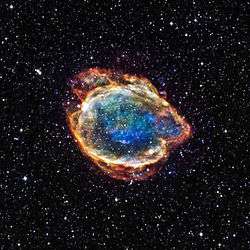Foe (unit)
A foe is a unit of energy equal to 1044 joules or 1051 ergs, used to express the large amount of energy released by a supernova.[1] A bethe (B) is equivalent to a foe.[2]
The word is an acronym derived from the phrase [ten to the power of] fifty-one ergs.[3] It was coined by Gerald Brown of Stony Brook University in his work with Hans Bethe, because "it came up often enough in our work".[4] The bethe is named after Hans Bethe. It was coined by Stephen Weinberg.[2]
This unit of measure is convenient because a supernova typically releases about one foe of observable energy in a very short period (which can be measured in seconds). In comparison, if the Sun had its current luminosity throughout its entire lifetime, it would release 3.827×1026 W × 3.1536×107 s/yr × 1010 yr ≈ 1.2 foe.
A foe is approximately 186.3 times the rest mass energy of the Earth.
See also
References
- ↑ Hartmann DH (April 1999). "Afterglows from the largest explosions in the universe". Proc. Natl. Acad. Sci. U.S.A. 96 (9): 4752–5. Bibcode:1999PNAS...96.4752H. doi:10.1073/pnas.96.9.4752. PMC 33568
 . PMID 10220364.
. PMID 10220364. - 1 2 Stephen Weinberg (2006). "A Bethe unit". Physics World. 19 (2). doi:10.1088/2058-7058/19/2/31.
- ↑ Marc Herant; Stirling A. Colgate; Willy Benz; Chris Fryer (October 25, 1997). "Neutrinos and Supernovae" (PDF). Los Alamos Sciences. Los Alamos National Laboratory. Retrieved 2008-04-23.
- ↑ Gerald Brown (2006). Hans Bethe and His Physics. World Scientific. ISBN 981-256-609-0.

